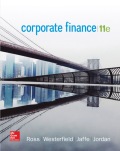
Stock Splits and Stock Dividends Roll Corporation (RC) currently has 465,000 shares of stock outstanding that sell for $73 per share. Assuming no market imperfections or tax effects exist, what will the share price be after:
- a. RC has a five-for-three stock split?
- b. RC has a 15 percent stock dividend?
- c. RC has a 42.5 percent stock dividend?
- d. RC has a four-for-seven reverse stock split?
Determine the new number of shares outstanding in parts (a) through (d).
a.
To determine: The share price and new number of shares outstanding at 5/3 stock split.
Introduction: The term dividends allude to that portion of proceeds of an organization which is circulated by the organization among its investors. It is the remuneration of the investors for investments made by them in the shares of the organization.
Answer to Problem 4QP
The share price is $43.80 and new number of shares outstanding is 775,000 shares at 5/3 stock split.
Explanation of Solution
Determine the share price at 5/3 stock split
Therefore the share price at 5/3 stock split is $43.80.
Determine the number of shares outstanding at 5/3 stock split
Therefore the number of shares outstanding at 5/3 stock split is 775,000 shares.
b.
To determine: The share price and new number of shares outstanding at 15% stock dividend.
Answer to Problem 4QP
The share price is $63.48 and new number of shares outstanding is 534,750 shares at 15% stock dividend.
Explanation of Solution
Determine the share price at 15% stock dividend
Therefore the share price at 15% stock dividend is $63.48.
Determine the number of shares outstanding at 15% stock dividend
Therefore the par value of per share at 15% stock dividend is 534,750 shares.
c.
To determine: The share price and new number of shares outstanding at 42.5% stock dividend.
Answer to Problem 4QP
The share price is $51.23 and new number of shares outstanding is 662,625 shares at 42.5% stock dividend.
Explanation of Solution
Determine the share price at 42.5% stock dividend
Therefore the share price at 42.5% stock dividend is $51.23.
Determine the number of shares outstanding at 42.5% stock dividend
Therefore the par value of per share at 42.5% stock dividend is 662,625 shares.
d.
To determine: The share price and new number of shares outstanding at 4/7 reverse stock split.
Answer to Problem 4QP
The share price is $127.75 and new number of shares outstanding is 265,714 shares at 4/7reverse stock split.
Explanation of Solution
Determine the share price at 4/7 reverse stock split
Therefore the share price at 4/7 reverse stock split is $127.75.
Determine the number of shares outstanding at 4/7 reverse stock split
Therefore the number of shares outstanding at 4/7 reverse stock split is 265,714 shares,
Want to see more full solutions like this?
Chapter 19 Solutions
EBK CORPORATE FINANCE
- You have an investment worth $61,345 that is expected to make regular monthly payments of $1,590 for 20 months and a special payment of $X in 3 months. The expected return for the investment is 0.92 percent per month and the first regular payment will be made in 1 month. What is X? Note: X is a positive number.arrow_forwardA bond with a par value of $1,000 and a maturity of 8 years is selling for $925. If the annual coupon rate is 7%, what’s the yield on the bond? What would be the yield if the bond had semiannual payments?arrow_forwardYou want to buy equipment that is available from 2 companies. The price of the equipment is the same for both companies. Silver Fashion would let you make quarterly payments of $14,930 for 8 years at an interest rate of 1.88 percent per quarter. Your first payment to Silver Fashion would be today. Valley Fashion would let you make X monthly payments of $73,323 at an interest rate of 0.70 percent per month. Your first payment to Valley Fashion would be in 1 month. What is X?arrow_forward
- You just bought a new car for $X. To pay for it, you took out a loan that requires regular monthly payments of $1,940 for 12 months and a special payment of $25,500 in 4 months. The interest rate on the loan is 1.06 percent per month and the first regular payment will be made in 1 month. What is X?arrow_forwardYou own 2 investments, A and B, which have a combined total value of $38,199. Investment A is expected to pay $85,300 in 6 years and has an expected return of 18.91 percent per year. Investment B is expected to pay $37,200 in X years and has an expected return of 18.10 percent. What is X?arrow_forwardYou own 2 investments, A and B, which have a combined total value of $51,280. Investment A is expected to pay $57,300 in 5 years and has an expected return of 13.13 percent per year. Investment B is expected to pay $X in 11 years and has an expected return of 12.73 percent per year. What is X?arrow_forward
- Equipment is worth $225,243. It is expected to produce regular cash flows of $51,300 per year for 9 years and a special cash flow of $27,200 in 9 years. The cost of capital is X percent per year and the first regular cash flow will be produced in 1 year. What is X?arrow_forward2 years ago, you invested $13,500. In 2 years, you expect to have $20,472. If you expect to earn the same annual return after 2 years from today as the annual return implied from the past and expected values given in the problem, then in how many years from today do you expect to have $55,607?arrow_forwardYou plan to retire in 5 years with $650,489. You plan to withdraw $88,400 per year for 20 years. The expected return is X percent per year and the first regular withdrawal is expected in 6 years. What is X?arrow_forward
 EBK CONTEMPORARY FINANCIAL MANAGEMENTFinanceISBN:9781337514835Author:MOYERPublisher:CENGAGE LEARNING - CONSIGNMENT
EBK CONTEMPORARY FINANCIAL MANAGEMENTFinanceISBN:9781337514835Author:MOYERPublisher:CENGAGE LEARNING - CONSIGNMENT
